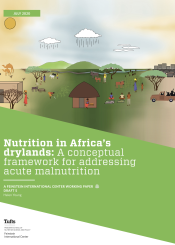- Patrizia Fracassi, Food and Nutrition Division, FAO
- Bibi Giyose, Senior Officer Nutrition and Food Systems & Advisor to the CEO, NEPAD
- Saul Guerrero, Senior Nutrition Advisor, Emergency Nutrition, UNICEF
- Nora Hobbs, Deputy of Systems Analysis for Nutrition, WFP
- Zita Weise-Prinzo, Department of Nutrition and Food Safety, World Health Organization
- Moderator: Helen Young, Professor and Research Director, Friedman School of Nutrition Science and Policy, Feinstein International Center
The revised framework preserves the immediate and underlying drivers of acute malnutrition and recognizes the synergism between them. More fundamentally, the updating reconceptualizes the basic more systemic drivers of acute malnutrition to include three interlinked areas:
- environment and seasonality;
- systems and institutions; and
- livelihood systems.
While this report is specifically about Africa’s drylands, 43% of the globe is classified as drylands and therefore may be relevant in other contexts.
In this video, Helen Young explains the urgency for better understanding the basic drivers of malnutrition, describes the adapted framework, and introduces this technical series.


No comments:
Post a Comment